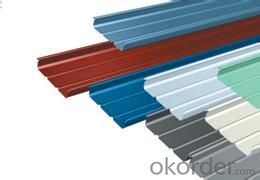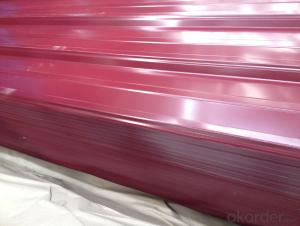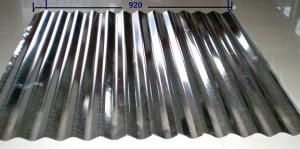Prepainted Galvanized Corrugated Steel plate :roofing sheet
- Loading Port:
- Tianjin
- Payment Terms:
- TT OR LC
- Min Order Qty:
- 30 m.t.
- Supply Capability:
- 500000 m.t./month
OKorder Service Pledge
OKorder Financial Service
You Might Also Like
Packaging & Delivery
| Packaging Detail: | Standard package for export |
| Delivery Detail: | 15 days after receipt the deposit or Original L/C |
Specifications
Prepainted roofing steel sheets
1. Thickness: 0.15mm---1.5mm
2. Width:800,900,1200,1220,1250mm
3.can be prepainted
Commodity | color coated galvanized steel plate |
Material | Galvanized steel sheet Galvalume steel sheet Pre-painted galvanized sheet |
Coating | PE,PVDF,galvanized(30-300g),galvalume (AZ80) |
Model No. | YX25-207-828 |
Sheet Thickness | 0.15---1.5mm |
Sheet Peak Height | 25mm |
Sheet Peak Spacing | 207mm |
Width | 800mm,900mm,1000mm |
Length | any length,according to the transportation,generally less than 12m |
Color | Standard color: red,blue,white grey Special color: according to RAL color |
Characteristic | 1 weatherproof 2 heating insulation 3 fireproof 4 anti-rust 5 sound insulation 6 long life span: more than 25 years
|
Packing | Plastic film,pallet or as your requests |
Delivery time | 15 days |
Payment | T/T,L/C |


Images:
- Q: What is the process of perforating steel sheets?
- The process of perforating steel sheets involves creating holes or patterns in the metal by using specialized machinery or tools. This can be done through various methods such as punching, drilling, or laser cutting, depending on the desired shape and size of the perforations. The perforation process allows for increased ventilation, light transmission, or aesthetic design in steel sheets, making them suitable for various applications in industries such as construction, automotive, or manufacturing.
- Q: Can the steel sheets be bent or formed into different shapes?
- Steel sheets have the ability to be bent or shaped into various forms. Steel possesses exceptional malleability, enabling it to be effortlessly manipulated and molded without any risk of fracture. This advantageous characteristic facilitates a broad spectrum of applications requiring the bending or shaping of steel sheets, particularly in the construction sector, where beams, columns, and other structural elements necessitate specific configurations. Depending on the desired outcome and the steel's thickness, a range of techniques such as cold forming, hot forming, and press braking can be employed to accomplish the task of bending or shaping steel sheets.
- Q: Are the steel sheets resistant to UV radiation?
- Generally, steel sheets are resistant to UV radiation. Steel, being a highly durable material, can endure exposure to different environmental factors, including UV radiation. However, the level of resistance may differ depending on the specific type of steel and its protective coating. Steel sheets with a superior protective coating, such as galvanized or stainless steel, exhibit greater resistance to UV radiation compared to bare steel. These coatings act as a barrier, preventing direct impact of UV rays on the steel surface and reducing the chances of degradation or discoloration. Moreover, regular maintenance and proper care can further bolster the steel sheets' resistance to UV radiation, ensuring their long-term durability and performance.
- Q: How do steel sheets compare to other materials like aluminum or copper?
- There are numerous advantages to using steel sheets over materials such as aluminum or copper. Firstly, steel is significantly stronger and more durable than both aluminum and copper. This makes steel sheets perfect for applications that require high strength and the ability to resist wear and tear, such as construction, automotive manufacturing, and industrial machinery. Secondly, steel sheets have a higher melting point than aluminum and copper. As a result, steel can withstand higher temperatures without deforming or melting, making it suitable for applications involving exposure to high heat or fire. Additionally, steel sheets are more cost-effective than both aluminum and copper. Steel is readily available and relatively inexpensive compared to these other materials. This makes steel sheets a more economical choice for large-scale applications that require a substantial amount of material. Furthermore, when properly coated or treated, steel sheets have excellent corrosion resistance properties. In contrast, aluminum and copper are more susceptible to corrosion and require additional protective measures. This makes steel sheets a superior choice for outdoor or marine applications where exposure to moisture and harsh environments is a concern. Lastly, steel sheets are highly recyclable, making them a more sustainable choice compared to aluminum and copper. Steel is one of the most recycled materials globally, with a recycling rate of nearly 90%. This reduces the environmental impact and conserves natural resources. In summary, steel sheets offer exceptional strength, durability, heat resistance, cost-effectiveness, corrosion resistance, and recyclability compared to materials like aluminum or copper. These qualities make steel sheets a versatile and reliable choice for a wide range of applications across various industries.
- Q: How do steel sheets resist fire?
- Steel sheets resist fire due to their high melting point and low thermal conductivity. When exposed to high temperatures, steel sheets do not easily ignite or burn. Instead, they act as a barrier, preventing the fire from spreading by maintaining their structural integrity. This resistance to fire enables steel sheets to provide stability and protection in buildings, making them a popular choice in construction and fire safety measures.
- Q: Can steel sheets be bent or folded?
- Yes, steel sheets can be bent or folded. Steel is a highly versatile material that can be manipulated into various shapes and forms. In fact, the ability to bend or fold steel sheets is one of the reasons why it is widely used in construction, manufacturing, and other industries. Bending or folding steel sheets can be achieved through different methods such as press braking, roll bending, or using specialized tools like bending machines. The process involves applying force or pressure to the steel sheet, causing it to deform and take on the desired shape.
- Q: What are the different sheet metal bending techniques for steel sheets?
- There are several sheet metal bending techniques commonly used for steel sheets. These techniques allow for the manipulation and shaping of steel sheets to achieve desired forms and angles. Some of the most common techniques include: 1. V-bending: This technique involves using a V-shaped punch and die set to create a sharp bend in the steel sheet. The material is placed between the punch and die, and force is applied to form the desired angle. V-bending is a versatile technique that can create various angles and shapes. 2. Air bending: In this technique, a punch is used to press the steel sheet into a V-shaped die, but without completely contacting the material. The bending is achieved by controlling the depth of penetration of the punch into the material. Air bending allows for greater flexibility in terms of angle adjustments and requires less force than other techniques. 3. Edge bending: As the name suggests, this technique involves bending the edge of the steel sheet. It is commonly used to create flanges or edges with specific angles. Edge bending is achieved by clamping the sheet between a punch and a die, and applying force to bend the material along the edge. 4. Bottom bending: This technique is used to create larger bends in steel sheets. It involves clamping the sheet between a punch and a V-shaped die, and then applying force to bend the material around the die. Bottom bending is suitable for creating U-shaped parts or boxes. 5. Roll bending: Also known as cylindrical bending, this technique is used to create cylindrical or curved shapes in steel sheets. The sheet is passed through a set of rolls, which gradually bend the material into the desired shape. Roll bending is commonly used in the production of pipes, tubes, and cylinders. 6. Coining: Coining is a precision bending technique that creates crisp, sharp bends. It involves pressing the steel sheet between a punch and a die, with the die featuring a sharp edge. The material is subjected to high pressure, resulting in a precise and defined bend. These are just a few of the many sheet metal bending techniques available for steel sheets. Each technique has its advantages and applications, and the choice of technique depends on factors such as the desired angle, the thickness of the sheet, and the complexity of the shape being formed.
- Q: Can steel sheets be used for manufacturing musical instruments?
- Yes, steel sheets can be used for manufacturing certain musical instruments, such as steel drums, tambourines, or some types of percussion instruments. However, they are not commonly used for traditional instruments like guitars, pianos, or brass instruments. The choice of materials for musical instrument manufacturing depends on the desired sound, resonance, and specific requirements of each instrument.
- Q: Are steel sheets suitable for battery enclosures or casings?
- Yes, steel sheets are often suitable for battery enclosures or casings due to their durability, strength, and ability to provide effective protection against external impacts or hazards.
- Q: What is the typical price difference between galvanized and non-galvanized steel sheets?
- The typical price difference between galvanized and non-galvanized steel sheets can vary depending on factors such as size, thickness, and market conditions. However, in general, galvanized steel sheets tend to be more expensive than non-galvanized ones, typically costing around 10-20% more.
Send your message to us
Prepainted Galvanized Corrugated Steel plate :roofing sheet
- Loading Port:
- Tianjin
- Payment Terms:
- TT OR LC
- Min Order Qty:
- 30 m.t.
- Supply Capability:
- 500000 m.t./month
OKorder Service Pledge
OKorder Financial Service
Similar products
Hot products
Hot Searches
Related keywords
































